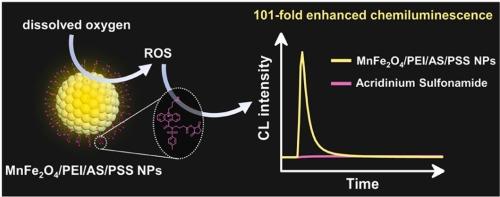溶解氧诱导吖啶鎓磺酰胺官能化 MnFe2O4 纳米粒子的高效化学发光,用于灵敏检测抗坏血酸
IF 8
1区 化学
Q1 CHEMISTRY, ANALYTICAL
引用次数: 0
摘要
开发以溶解氧为核心活性剂的高效化学发光(CL)功能化纳米材料用于分析传感仍是一项重大挑战。在本研究中,我们以聚乙烯亚胺(PEI)为桥,以聚(4-苯乙烯磺酸钠)(PSS)为稳定剂,合成了新型吖啶磺酰胺(AS)功能化的 MnFe2O4 纳米粒子,称为 MnFe2O4/PEI/AS/PSS NPs。这些 MnFe2O4/PEI/AS/PSS NPs 以溶解氧为核心反应物,在十六烷基三甲基氢氧化铵(CTAOH)存在下表现出很强的 CL 发射。这种增强的 CL 性能归因于几个因素:MnFe2O4/PEI NPs 上的大比表面积和丰富的氨基基团实现了高 AS 负载效率;表面结合的 Mn2+ 和 Fe2+ 离子在从溶解氧中生成活性氧方面具有催化活性;CTAOH 形成的带正电荷的胶束富集了超氧阴离子。此外,PSS 还能保护 N-(3-磺酸丙烷)吖啶酮的激发态免受环境淬灭,延长其寿命并增强 CL 发射。此外,MnFe2O4/PEI/AS/PSS NPs 还具有优异的磁性能和稳定性。在此基础上,以 MnFe2O4/PEI/AS/PSS NPs 为检测平台,开发了一种灵敏的抗坏血酸(AA)CL 检测方法,无需识别元素。其检测范围为 0.08-200 µM,检测限低至 0.0714 µM。该方法快速、简单、环保、稳定,无需孵育过程和额外的核心反应物。CL 方法有效地检测了人血清样本中的 AA,凸显了其在临床诊断中的应用潜力。本文章由计算机程序翻译,如有差异,请以英文原文为准。

Dissolved Oxygen-Induced Highly Efficient Chemiluminescence of Acridinium Sulfonamide-Functionalized MnFe2O4 Nanoparticles for Sensitive Detection of Ascorbic Acid
The development of efficient chemiluminescence (CL)-functionalized nanomaterials that use dissolved oxygen as a coreactant for analytical sensing remains a significant challenge. In this study, we present the synthesis of novel acridinium sulfonamide (AS)-functionalized MnFe2O4 nanoparticles, denoted as MnFe2O4/PEI/AS/PSS NPs, utilizing polyethyleneimine (PEI) as a bridge and poly(sodium 4-styrenesulfonate) (PSS) as a stabilizer. These MnFe2O4/PEI/AS/PSS NPs exhibited strong CL emission with the dissolved oxygen as a coreactant in the presence of hexadecyltrimethylammonium hydroxide (CTAOH). This enhanced CL performance was attributed to several factors: the large specific surface area and abundant amino groups on the MnFe2O4/PEI NPs, which enabled high AS loading efficiency; the catalytic activity of surface-bound Mn2+ and Fe2+ ions in generating reactive oxygen species from dissolved oxygen; and the positively charged micelles formed by CTAOH, which enriched superoxide anions. Additionally, PSS protects the excited state of N-(3-sulfonate-propane)acridone from environmental quenching, extending its lifetime and enhancing CL emission. Moreover, the MnFe2O4/PEI/AS/PSS NPs also demonstrated exceptional magnetic performance and stability. Based on this, a sensitive CL method for ascorbic acid (AA) detection was developed using MnFe2O4/PEI/AS/PSS NPs as a detection platform, without the requirement for recognition elements. The detection range was 0.08-200 µM with a low detection limit of 0.0714 µM. This method is rapid, simple, environmentally friendly, and stable, as it eliminates the need for an incubation process and additional coreactants. The CL method was effectively employed for the detection of AA in human serum samples, highlighting its potential for clinical diagnosis applications.
求助全文
通过发布文献求助,成功后即可免费获取论文全文。
去求助
来源期刊

Sensors and Actuators B: Chemical
工程技术-电化学
CiteScore
14.60
自引率
11.90%
发文量
1776
审稿时长
3.2 months
期刊介绍:
Sensors & Actuators, B: Chemical is an international journal focused on the research and development of chemical transducers. It covers chemical sensors and biosensors, chemical actuators, and analytical microsystems. The journal is interdisciplinary, aiming to publish original works showcasing substantial advancements beyond the current state of the art in these fields, with practical applicability to solving meaningful analytical problems. Review articles are accepted by invitation from an Editor of the journal.
 求助内容:
求助内容: 应助结果提醒方式:
应助结果提醒方式:


